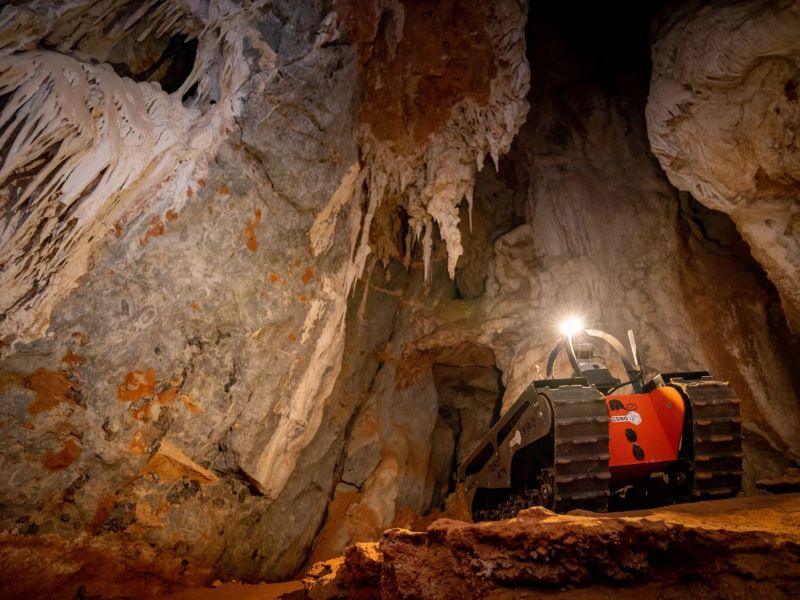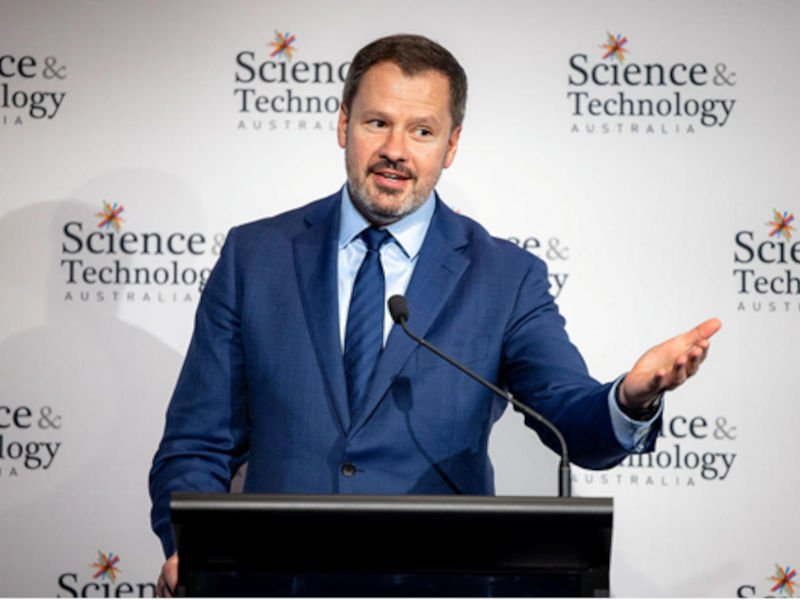After warnings Australia is again giving up its lead in an emerging technology, Industry and Science Minister Ed Husic has promised a more strategic approach to robotics, including the development Australia’s first national strategy.
It will launch after a national quantum strategy next year and follows a similar national push for AI. It is another sign of the new government’s intent to back certain technologies it sees as impactful, job-creating future industries.
But the details of a national strategy for a sector known to be complex and fragmented are shaping as a key challenge for whoever Mr Husic appoints to lead its creation later this year.

While Australia competes globally on robotics research and certain capabilities, the technology has not taken hold across the wider economy.
According to Robotics Australia, the country’s robot population density – a measure of the number of industrial robots per 10,000 employees, is 75, while the world average is 113.
The peak body says Australia is “being left behind” right as the technology evolves into a much more useful tool.
“Australia needs to back itself to be not just a consumer but a creator of robotics and robotics-related technologies, Robotics Australia says in its own roadmap for the sector earlier this year
“Such ambition will see us realise the full benefits of these emerging technologies and ensure we have sovereign capability across all of our important supply chains. It will also open up new export markets in this high growth sector, where average Compound Annual Growth Rate for field robots, one of Australia’s areas of niche expertise, is 31 per cent.”
Mr Husic says he’s heard the call, announcing a plan last month for Australia’s first ever national robotics strategy shortly after meeting with the group.
The minister has earmarked robotics, AI and quantum among a handful of critical technologies for more strategic support from the government in a bid to improve economic complexity.
“Economies will either be makers or takers,” Mr Husic said when announcing the robotics strategy.
“We are either going to use our brains to do things differently and increase that complexity within an economy or we’re just going to import someone else’s ideas.”
Behind the scenes in the Industry department, Anthony Murfett is in charge of the government’s emerging technology push as head of division technology and national security. He’s bullish on Australia’s current robotics capabilities and its potential across the economy.
“We’re putting a 20 kilo rover on the surface of the moon. NASA is flying it there for us. The reason [NASA is] doing that is because of our automation and robotics technology. We’ve got capabilities that NASA don’t have, and they need us to do.”
Mr Murfett, who helped develop Australia’s space industry as deputy head of the Australian Space Agency, said the government will again look to identify areas of excellence and “core capabilities” that can transfer into other areas of the economy.
“What do we need to grow and nurture? I know we can’t do everything. So where do we invest that makes sense? And if I look at robotics, we’re really good at field robotics. It’s about looking at the areas of the economy that we have [and find] where can we pivot and where can we transition.”
The likely move to double down on field robotics is not surprising given the achievements of Australian roboticists.

Professor Hugh Durrant-Whyte from Sydney University and now the NSW chief scientist and engineer invented simultaneous localisation and mapping, or ‘SLAM’, the widely used computational problem of constructing or updating a map of an unknown environment while simultaneously keeping track of an agent’s location within it.
Professor Rodney Brooks emerged from Flinders University to lead prestigious robotics programs in US universities before founding iRobot, the company behind the successful Roomba robots.
And just last year, a team of CSIRO scientists and team mates from robotics company Emesent and Georgia Tech lost a photo finish to place second in America’s DARPA SubT challenge, considered the “robot Olympics”.
The achievements, and a resource sector that arguably leads the world in robotics and automation, have helped cement Australia as a global standout in field robotics, and made the are a likely focus of a national strategy.
“If Australia were to play to its strengths, then Australia would be choosing Field Robotics and situational awareness, and also trusted autonomy,” CSIRO executive director of digital, national facilities and collections, professor Elanor Huntington said.
They’re the places where we already have strengths. So if we were to choose to play to our strengths, then that’s the place that we would we would certainly choose to go,” she told InnovationAus.com.
Professor Huntington also wants the upcoming strategy to address the fragmented nature of the current robotics sector.
“It’s difficult for us to kind of come together and get to scale,” she said. “We do actually have some areas of concentrations of strength in Australia. But it’s an ecosystem, it’s a large ecosystem, it’s a dynamic ecosystem, [and] it’s a bit fragmented.”

How much to back areas of strength like field robotics, and how to do so without stymying other areas, is emerging as a key challenge for the inaugural national strategy strategy.
Will Browne, a professor and chair in manufacturing robotics, apposition held through QUT, the Advanced Robotics Manufacturing (ARM) Hub and CSIRO, agrees there are clear areas of strength to double down on, but he warns the strategy should not ignore other robotics opportunities, even if Australia may not have quite as big of a head start.
“Field robotics, mining robotics, agricultural robotics, and intelligent robotics are all strong strengths that we should play to. But manufacturing robots is going to be a huge growth area and it has to be for Australia.
“Our GDP share of manufacturing is around seven per cent. Why isn’t it 14 to 20 per cent like other OECD countries? In order to do that, robotics has got to play a central part to it.”
With an aging population and a service-based economy, it would be wise for the strategy to explore health robotics as well, including the less attention grabbing applications.
“The robots that I can see helping [in health] is someone needs to lift a patient off of bed, you call a robot to help, someone needs to change a sheet you have a robot that changes your sheet,” Professor Browne said.
“So you have the human being interacting with the patient and making those sorts of decisions, but you have the robots doing the dull, dirty, dangerous jobs.”
Professor Browne said the strategy needs to address three key areas: education & skills, scaling companies, and creating the robotics ecosystes that fosters R&D.
A national robotics strategy could set a direction for high school, TAFE and university education, establish the grants businesses need to work with universities and other partners, and expand the robotics hubs across the country to give Australia’s mostly small businesses more access to these advanced technologies.
“The idea is having hubs that can really support businesses and particularly small businesses,” Professor Browne told InnovationAus.com.
“Because large companies like Boeing, they’re going to do robotics when it makes sense on their balance sheet. For the small companies who could really benefit — from the ginger producers to the companies that do stents, to the companies that develop hearing aids — they’re the companies that could really benefit from robotics.”
Professor Cori Stewart leads the ARM Hub in Queensland, an initiative set up to accelerate businesses adoption of robotics and digital transformations.
She also welcomes the strategy but warns it can’t be developed in isolation from wider industrial policy. Instead, it must be a key plank of the bigger policy.
“Robotics is key to digitally transforming industry, creating new industries of global impact, and skilling Australians to work in these high-value industries,” she told InnovationAus.

“I am excited that Australia’s recognised leadership in robotics could be a flagship strategy and capability driving forward a coherent national industry policy for the nation,” Professor Stewart said.
“A national robotics strategy has the opportunity to expand Australia’s sovereign capability by linking with the nation’s emerging network of industry innovation hubs. These hubs, like the ARM Hub in Queensland and Tonsley in South Australia, are solving the industry’s toughest problems while scaling Australia’s sovereign manufacturing capability.”
If the strategy is successful it will mean Australian industry reaps the benefits of our robotics capability while ensuring robotics companies are competitive globally, she said.
Parts of the sector aren’t waiting for the government’s plan to fix certain deficiencies, not least of which is a lack of diversity. Robotics is no exception to the underrepresentation across STEM sectors, Professor Huntington said.
“It draws on physics, maths, computer science [and] AI skills. So in order to get to PhD in robotics stage you kind of need to have started from there…If you’re coming out of those computer science, engineering, physics disciplines, then you’ve come through an undergraduate degree and the numbers are the numbers.”
But representation is improving in robotics, she said, as robotics attracting more expertise from fields further afar like psychology and social science. The national science agency is investing in a more diverse robotics workforce itself.
CSIRO has taken the $1.2 million prize money it won at last year’s robot Olympics and invested it in a new scholarship program at the Queensland University of Technology.
The new Alberto Elfes Memorial Scholarship Fund, in honour of the late Professor Alberto Elfes, a revered leader of CSIRO’s Robotics programs, will sponsor eight scholarships for domestic or international high-performing students belonging to groups under-represented in the robotics industry.
“Innovation is accelerated when you have a diverse cohort of people who bring different perspectives, different ways of thinking to a particular problem….[But] one of the challenges in getting and maintaining diversity in these disciplines is actually that not only do not do we not have a very diverse cohort coming in, but also there’s a higher attrition rate for people who are underrepresented.,” Professor Huntington said.
“I can speak from personal experience here. It can actually be quite a lonely experience. So the opportunity was to create a cohort and hopefully have people not have such a lonely experience.”
Australia’s national robotics strategy is expected to be finalised by March next year.
This article was updated to clarify the members of CSIRO’s DARPA SubT team included members from Emesent and Georgia Tech, not QUT as an earlier version stated.







